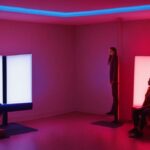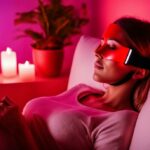Last Updated on 1 year by Francis
Light therapy is a treatment method that involves exposure to specific wavelengths of light. It has been shown to be effective in treating seasonal affective disorder, sleep disorders, and other conditions. However, it is important to know when to do light therapy in order to experience its benefits without negative side effects. In this article, we will discuss the best times to utilize light therapy and important factors to consider when incorporating it into your routine.
Contents
Understanding Light Therapy
Light therapy is a non-invasive treatment that uses specific wavelengths of light to improve mood, sleep, and skin health. This therapy is also known as phototherapy, bright light therapy, or light box therapy. It is used to treat a variety of conditions, including seasonal affective disorder (SAD), depression, sleep disorders, and skin conditions such as psoriasis and eczema.
The Science Behind Light Therapy
Light therapy works by exposing the body to specific wavelengths of light that mimic natural sunlight. This exposure triggers a biochemical response in the body, which can lead to a range of health benefits. Light therapy has been shown to increase the production of serotonin, a neurotransmitter that regulates mood and sleep. It also helps to regulate the body’s circadian rhythm, which can improve sleep and reduce symptoms of SAD.
The Benefits of Light Therapy
Light therapy has many benefits, including:
- Improved mood and energy levels
- Reduced symptoms of depression and anxiety
- Improved sleep quality and duration
- Reduced symptoms of SAD
- Improved skin health and reduced symptoms of skin conditions such as psoriasis and eczema
Morning vs. Evening Treatment
The timing of light therapy can have a significant impact on its effectiveness. Research has shown that morning light therapy is more effective for improving mood and energy levels, while evening light therapy is more effective for improving sleep quality and duration.
If you’re using light therapy to treat SAD or depression, it’s recommended that you do your treatment in the morning. This is because exposure to bright light in the morning can help reset your circadian rhythm and improve your mood and energy levels throughout the day. If you’re using light therapy to improve sleep, it’s recommended that you do your treatment in the evening, as exposure to bright light in the evening can disrupt your circadian rhythm and make it harder to fall asleep.
Duration of Treatment
The duration of light therapy treatment can vary depending on the condition being treated and the severity of symptoms. Most people will start to see improvements within 2-4 weeks of starting light therapy, but it may take up to 8 weeks for full benefits to be realized.
For SAD and depression, it’s recommended that you do light therapy for 30 minutes to 1 hour each day. For sleep disorders, it’s recommended that you do light therapy for 30 minutes to 2 hours each evening.
Frequency of Treatment
The frequency of light therapy treatment can also vary depending on the condition being treated and the severity of symptoms. Most people will do light therapy every day, but some may only need to do it a few times a week.
For SAD and depression, it’s recommended that you do light therapy every day throughout the fall and winter months. For sleep disorders, it’s recommended that you do light therapy every day for several weeks to establish a regular sleep-wake cycle.
Other Factors to Consider
In addition to the timing, duration, and frequency of treatment, there are other factors to consider when doing light therapy. These include:
- Type of light box: There are many different types of light boxes available, and it’s important to choose one that delivers the appropriate level of light intensity and wavelength for your condition.
- Distance from light box: The distance between you and the light box can also have an impact on the effectiveness of treatment. It’s important to follow the manufacturer’s instructions for the appropriate distance.
- Eye protection: Bright light can be harmful to the eyes, so it’s important to wear eye protection when doing light therapy.
- Medications: Some medications can increase sensitivity to light, so it’s important to talk to your healthcare provider before starting light therapy if you’re taking any medications.
FAQs for When to Do Light Therapy
What is light therapy and how does it work?
Light therapy is a treatment that involves exposing individuals to bright light for a specific amount of time each day. This light is typically in the form of a lightbox that produces a bright light similar to daylight. The therapy works by affecting the body’s biological clock and resetting it, which can help regulate sleep-wake patterns, improve mood, and alleviate symptoms of certain conditions like seasonal affective disorder (SAD).
When should I do light therapy?
The best time to do light therapy depends on the individual’s circadian rhythm and their specific needs. For individuals with seasonal affective disorder, it’s recommended to do light therapy in the morning to help reset their body’s internal clock and improve alertness during the day. However, individuals who work night shifts or have delayed sleep-wake phase syndrome may benefit from doing light therapy in the evening to help shift their body’s natural sleep cycle.
How long should I do light therapy for?
Typically, light therapy sessions last between 20-30 minutes per day, but the duration can vary depending on the individual’s needs and the intensity of the light. It’s important to consult with a healthcare professional before starting light therapy to determine the appropriate duration and intensity of the light needed for each individual.
What are the potential side effects of light therapy?
Light therapy is generally considered safe and has few side effects. The most common side effects reported are headaches, eyestrain, and nausea. These side effects are typically temporary and subside with continued use. However, it’s important to consult with a healthcare professional if any side effects persist or worsen.
Can I do light therapy if I have an existing medical condition?
Individuals with certain medical conditions should consult with a healthcare professional before starting light therapy. Conditions such as bipolar disorder, skin conditions that are worsened by light exposure, and certain eye problems may be worsened by light therapy. Additionally, certain medications like antibiotics, anti-inflammatories, and medications that increase sensitivity to sunlight may also interfere with light therapy. Therefore, it’s important to discuss any existing medical conditions and medications with a healthcare professional before starting light therapy.







